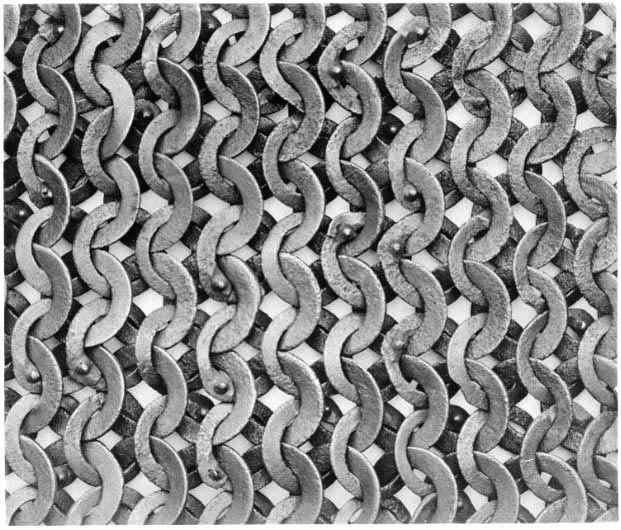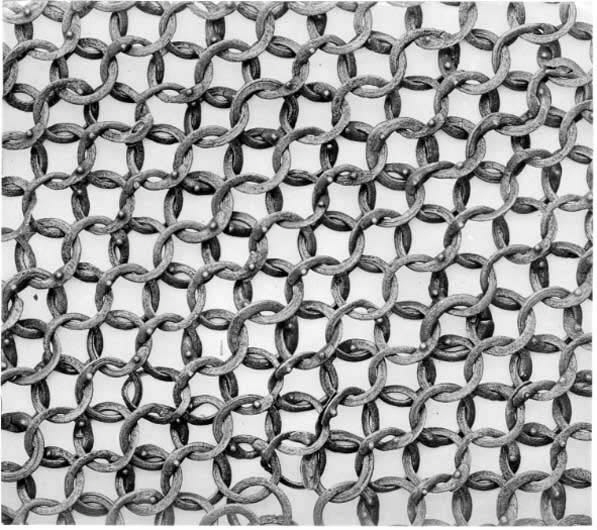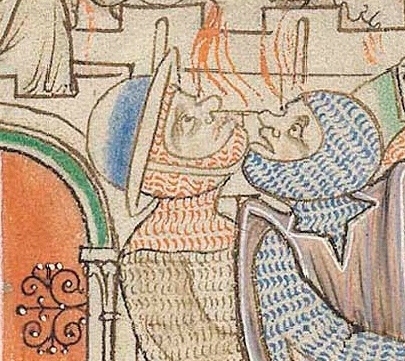I've noticed that most of the paintings showing armies of full-plate men-at-arms have everyone fully armoured in dark black plate.
I know they also used to blacken their mailles with oils of some sort.
Japaneses were also famous for applying painting (lacquer?) to their lamellar armour.
The colouring protects against rust and the weather, so it makes sense for everyone to have coloured armour instead of bare, oiled silver steel.
But pretty much every piece of medieval armour in museums are clean, silver steel.
Do they simply remove the colour in restoration cleaning, or does the colour simply fades out after time, or did they simply... just didn't colour their armour in medieval Europe?
And if they did, what were the common colours? Or did everyone just wear black plate?
Sorry if this has been discussed around here before.
There was a lot of variation according to time, place and style of armor. You could see anything from blackened to polished, painted or fabric covered. Sometimes they even concealed the armor under other garments! Another thing to consider is that silver, the actual precious metal, was sometimes used in silver paint. They say that before the Industrial Revolution there wasn't enough sulfur in the atmosphere for silver to tarnish on its own but it certainly does now so many times things can appear black in ancient art when in fact they were meant to be silver.
I like to cook on cast iron so I really dig the concept of baked on vegetable oil finishes for swords, armor and other things. I've found "seasoning" to be a much better finish that gives more protection than simply oiling a surface. If you're careful and lucky you can actually use heat to form colorful oxides on the surface of a piece of steel and then seal them with a relatively thin, mostly transparent film of baked on soybean oil.
I like to cook on cast iron so I really dig the concept of baked on vegetable oil finishes for swords, armor and other things. I've found "seasoning" to be a much better finish that gives more protection than simply oiling a surface. If you're careful and lucky you can actually use heat to form colorful oxides on the surface of a piece of steel and then seal them with a relatively thin, mostly transparent film of baked on soybean oil.
| Rafaello F. S. wrote: |
| I've noticed that most of the paintings showing armies of full-plate men-at-arms have everyone fully armoured in dark black plate. |
Not trying to be rude, but you probably simply haven't seen enough paintings and miniatures. There's a huge variation in how the "colour" of plate armour was depicted in medieval European art, from black to blue to gold to silver-white and all sorts of colours.
| Quote: |
| The colouring protects against rust and the weather, so it makes sense for everyone to have coloured armour instead of bare, oiled silver steel. |
Not necessarily. "White" armour required a fair amount of effort to keep them that way, and mirror-polished armour would have taken hours upon hours of a well-trained armour polisher's time to maintain their condition. It'd be the perfect way to show off just how wealthy and influential the owner/wearer was (by hinting at the fact that he could pay for the full-time services of a personal armourer, or at least to make frequent visits to a professional armour-polisher's shop).
| Quote: |
| But pretty much every piece of medieval armour in museums are clean, silver steel. |
Not really. In some cases we're lucky enough to have the original blackened/blued, gilded, or etched/engraved surfaces preserved. Of course, such pieces in their original condition are a minority, which brings us to your next point.
| Quote: |
| Do they simply remove the colour in restoration cleaning, or does the colour simply fades out after time, or did they simply... just didn't colour their armour in medieval Europe? |
The first, mostly. 19th-century and early 20th-century museum people liked the look of shiny "white" armour and in many cases polished out the original finish in order to get this look. Still, we can't ignore the many pieces of armour were originally meant to be worn and displayed "white."
| Quote: |
| And if they did, what were the common colours? Or did everyone just wear black plate?
Sorry if this has been discussed around here before. |
All sorts of colour. Thinking that plate armour was all "black" is just as silly as the conceit that they were all "white." The fact is that there was a bewildering variety of finishes, coverings, and surface treatments for medieval and Renaissance plate armour.
http://myArmoury.com/talk/viewtopic.php?t=2700
http://myArmoury.com/talk/viewtopic.php?t=20995
http://myArmoury.com/talk/viewtopic.php?t=244...ight=blued
http://myArmoury.com/talk/viewtopic.php?t=229...ight=black
http://myArmoury.com/talk/viewtopic.php?t=201...ight=black
http://myArmoury.com/talk/viewtopic.php?t=186...ht=painted
http://myArmoury.com/talk/viewtopic.php?t=288...ht=painted
http://myArmoury.com/talk/viewtopic.php?t=128...ht=painted
http://myArmoury.com/talk/viewtopic.php?t=762...ht=covered
There is one reason armour may have been painted, is that it's a fast and cheap to personalize armour,
even just a simple paten or a few basic shapes do the job.
Later the paint can be scrubbed off and you can have nice shiny armour in time for your victory parade.
even just a simple paten or a few basic shapes do the job.
Later the paint can be scrubbed off and you can have nice shiny armour in time for your victory parade.
| Rafaello F. S. wrote: |
| I know they also used to blacken their mailles with oils of some sort. |
I would be interested to see any evidence you have for this in a European context.
There is ample evidence for covering plate armor with fabric or leather, which also makes a variety of colors available.
The Mack bible has examples of blackened maille, the Trinity Apocalypse has coloured maille in it.
Could be oil, paint or artistic licence.
Could be oil, paint or artistic licence.
| Roderick Stacey wrote: |
| The Mack bible has examples of blackened maille, the Trinity Apocalypse has coloured maille in it.
Could be oil, paint or artistic licence. |
The only folios of the Maciejowski Bible which has "black" mail are the few folios using silver, which has tarnished. To quote from Old Testament Miniatures, p.20,
| Sydney C. Cockerell wrote: |
| Silver occurs only on the few leaves I have ascribed to Hands 2 and 3. |
Folio 28 recto in the Trinity is another example of tarnished silver.
But not the blue or the red maille?
I had not heard previously that the black maille is tarnished silver. Very interesting!
I had not heard previously that the black maille is tarnished silver. Very interesting!
| Roderick Stacey wrote: |
| But not the blue or the red maille?
I had not heard previously that the black maille is tarnished silver. Very interesting! |
Red, blue, and green are common in manuscripts, though a blue or blue-gray are most common. Some use black ink on white parchment or alternating black and white marks over a blue wash. The miniaturists have a limited pallet, and might be trying to help differentiate figures. Or the colors could be indicative of something. Mail being porous also allows the color of underlying garments to come through, so we might be seeing natural green linen aketons or red-fabric aketons showing through.
We do have evidence and extant examples of latten (copper alloy, usually brass) mail, and gilt mail. So yellow, oranges or reds might be an attempt to show that. On the other hand angels are sometimes depicted as red because they have faces which "shone as the sun" per various Biblical passages. Medieval man made a closer association of shining or glowing with the color of fire than we do with our electric lights.
I had a discussion on this topic over at Armour Archive, and can provide literary sources describing mail as bright, glowing, white, glistening, etc., and descriptions of mail being polished by squires. Likewise we have records of men being paid to tumble mail to clean it, but no records of payment for mail to be blackened that I have found.
The various depictions of mail in medieval manuscripts ( and how early "Antiquarians" interpreted these) is a topic which deserves lengthy study. Throw in stained glass, frescoes, and monumental sculpture and some art major has a doctoral thesis topic!
| Rafaello F. S. wrote: |
| But pretty much every piece of medieval armour in museums are clean, silver steel.
Do they simply remove the colour in restoration cleaning, or does the colour simply fades out after time, or did they simply... just didn't colour their armour in medieval Europe? |
Your suspicions here are often correct. Many early collectors and curators removed colored surfaces from armor to make it look more 'correct' (failing to realize that these surfaces were original - the same thing happened to a lot of medieval churches in the 19th century when restorers mistook original paint for a more recent addition and removed it to 'return' the buildings to their suposedly medieval appearance). And many artifacts found in archaeological contexts are very corroded, with destroys the outermost layer of metal where the original surface would have been.
You can read more about this in an article by Brian Gilmour. I unfortunately don't have a link to the full article, but this link has the abstract and citation: https://www.academia.edu/3117710/What_Did_Iron_Really_Look_Like_Patination_and_Coloring_Treatments_on_Iron_and_Steel
---
Abstract:
Title: What Did Iron Really Look Like? Patination and Coloring Treatments on Iron and Steel
Author: Brian Gilmour
Over the past century, the powerful but mythical image of knights in shining armour, with bright polished swords to match, has dominated our view of what ironwork looked like: that of a polished greyish-white metal. This impression is gained not only from descriptions and illustrations in many books but is also obvious from even a casual walk around museum collections specializing in high status ironwork (such as the Royal Armouries in Leeds). But a close examination of much of this ironwork is likely to reveal that this was not its original appearance. Many poorly preserved patinated surfaces have been mistakenly removed by restorers and conservators wishing to improve the appearance of the objects in their care, not realizing they were altering the appearance by removing surviving traces of the original surface.However, it is possible to work out what much early iron or steelwork was originally intended to look like even if very little of the original surfaces survive. This can be done by the study of a combination of things: actual surviving traces, related decorative features (such as inlays), early descriptions, pictures, and even the use of inhomogeneous metal for certain objects or the making of composite ferrous artifacts. From this we can start to find out that much ironwork was actually intended to be either one or more colors, mostly in the range black (hence blacksmith) or dark grey to brown or blue, sometimes with one color intended to show up in contrast to another, or to a decorative feature such as an inlay. The probability that induced patination on iron surfaces was also intended to serve as a protective film is also indicated by some written sources. These issues need to be examined to promote a much better understanding of this little understood aspect of early ferrous metalwork, both to find out how and why it was intended to look originally and avoid bad decisions on how it should be cared for and displayed.
Publication Date: 2009
Publication Name: Materials and Manufacturing Processes
Here is an old thread about the blackened mail, there is some slight evidence listed, but not really conclusive.
http://myArmoury.com/talk/viewtopic.php?t=188...mp;start=0
http://myArmoury.com/talk/viewtopic.php?t=188...mp;start=0
| Mart Shearer wrote: | ||
Red, blue, and green are common in manuscripts, though a blue or blue-gray are most common. Some use black ink on white parchment or alternating black and white marks over a blue wash. The miniaturists have a limited pallet, and might be trying to help differentiate figures. Or the colors could be indicative of something. Mail being porous also allows the color of underlying garments to come through, so we might be seeing natural green linen aketons or red-fabric aketons showing through. topic! |
Maille is not that porous, often you just see maille and no idea what is underneath.
It maybe to highlight different figures in an image which does breakup a mob of warriors.
| Roderick Stacey wrote: | ||
Maille is not that porous, often you just see maille and no idea what is underneath. It maybe to highlight different figures in an image which does breakup a mob of warriors. |
Some mail is more porous than others. Two examples from the Livrustkammaren illustrate the point.
Distinguishing individuals in the mob, or sometimes even distinguishing one item of mail from another, such as hauberk from coif is only one possible explanation for the deviation in color used.

Inv. # 22284 (4816)

Inv. # 23208 (5124)

CambridgeMS R.16.2 fo.24r "Trinity Psalter"
Page 1 of 1
You cannot post new topics in this forumYou cannot reply to topics in this forum
You cannot edit your posts in this forum
You cannot delete your posts in this forum
You cannot vote in polls in this forum
You cannot attach files in this forum
You can download files in this forum
All contents © Copyright 2003-2006 myArmoury.com — All rights reserved
Discussion forums powered by phpBB © The phpBB Group
Switch to the Full-featured Version of the forum
Discussion forums powered by phpBB © The phpBB Group
Switch to the Full-featured Version of the forum